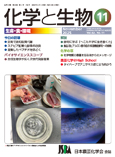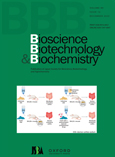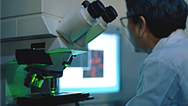[on September 18, 2021]
Visionary NOUGEIKAGAKU 100
Symposium(3) on Food, Intestinal Bacteria and Health Research Areas: New era of gut microbiology toward health and long life
Date & venue; Online on September 18, 2021
1. Food, Microbiota, and Lifestyle disease of Asians
Jiro Nakayama, Faculty of Agriculture, Division of Systems Bioengineering, Kyushu University
Recent increase in the population of lifestyle disease patients such as obesity and type 2 diabetes (T2D) is serious social problem. It is likely due to introduction of Western diets containing high fat and simple sugar in addition to high glycemic rice-based dietary style. On the other hand, recent progress on intestinal microbiology has reveals that gut microbiota consisting of a hundred trillions bacterial cells play important roles as an interface between food and host health and sometimes associate with such lifestyle diseases. Therefore, we have established Asian Microbiome Project (AMP) to monitor the condition of gut microbiota of people in Asian countries. Thus far, we have notably focused on gut microbiota of school-age children whose microbiota is considered crucial for the health of later life and patients of obesity and T2D as representative of diet-driven lifestyle diseases.
The gut microbiomes of Asians mirror dietary habits in each country, although they are basically classified into two types, each driven by Bacteroides and Prevotella. These two types are mainly observed in developed and developing area, respectively, and we found that the loss of classical type of dietary habit drives shift from Prevotella type to Bacteroides type in addition to decrease of fermentative production of short chain fatty acids which have indispensable role to maintain host metabolic and energy homeostasis. These findings suggest that although Asian microbiome reflects goodness of Asian traditional foods, the introduction of modern diets has started remodeling Asian gut microbiome, this warrants retrospective studies to close up benefits of Asian traditional foods.
2. How is your intestine? The future of your health from the intestinal perspective
Jun Kunisawa, Center for Vaccine and Adjuvant Research & Collaborative Research Center for Health and Nutrition, National Institutes of Biomedical Innovation, Health and Nutrition (NIBIOHN)
Both diets and intestinal bacteria are recognized as an important factor from the perspective of our health. Biological functions of the intestine include digestion and absorbance of dietary components, and also an immune system. The intestinal immunity affects the balance of immunity not only in the intestinal but also in the whole body, and thus is also involved in the development of various diseases. We are currently conducting research to create a new social system that aims at health from the intestine. In this talk, I show our research from the viewpoint of "immune regulation by dietary metabolites" which is linked to analysis using data of lifestyle (e.g., diet) and various biological molecules conducted on people living in various parts of Japan, and mechanism elucidation through basic research.
3. Insights into the reason and potential role of Bifidobacterium being the natural inhabitant of the infant gut
Jin-zhong Xiao (Shimizu Kanetada), Next Generation Science Institute, Morinaga Milk Industry Co., Ltd.
Bifidobacterium is one of the most abundant bacterial genera in the gut microbiota of infants and is believed to exert beneficial effects on the maturation of the immune, digestive and metabolic systems, as well as in the protection against pathogens and the prevention of allergies. The genus Bifidobacterium has been known to contain >90 species/subspecies, but only a few of them are known as typical inhabitants of the human gut (designated as human-residential Bifidobacterium, HRB). Accumulating evidence suggests that HRB possess unique physiological characteristics including high compatibility with human milk, adapted metabolic affinities, and capabilities to produce beneficial metabolites. This presentation will introduce the results of our research, including the characteristics of HRB, the reasons why it lives in the human intestinal tract and its potential health functions, as well as the latest results of clinical trials on the effect of B. breve MCC127 intake on cognitive function.
4. Relationships between gut microbiota and health clarified through interaction studies between intestinal bacteria and bile acids
Atsushi Yokota, Research Faculty of Agriculture, Hokkaido University
My bile acid research started from my study abroad at the University of Groningen in the Netherlands under the supervision of Prof. Dr. W. N. Konings. First I clarified the interactions among bacterial membrane and bile acids mainly using lactic acid bacteria and bifidobacteria. Through these studies, I conceived the idea that bile acid regulates the gut microbiota structure via its bactericidal activity. Animal experiments feeding bile acids or high-fat diets revealed not only the regulatory role of bile acids but also the induction of fatty liver via dysbiosis. Collectively, my agricultural chemistry-oriented studies surely indicated the role of bile acid as a responsible molecule connecting the diet–gut microbiota–disease triangle.
5. Interactions between food function and microbial function
Jun Ogawa, Div. Appl. Life Sci., Grad. Sch. Agric., Kyoto University
Food components and physiological functions derived from food components and microorganisms and microbial functions support each other in terms of health promotion. Microorganisms related to food functions include intestinal bacteria and microorganisms involved in fermentation and brewing. How intestinal bacteria can elicit physiological functions from food components is becoming clear. The metabolism of intestinal bacteria induces molecules from food components that cannot be produced by the host, and that these molecules create new physiological functions that have not been discovered before, as found in gut microbial metabolism of polyunsaturated fatty acids and plant-derived bioactive compounds such as glucosinolates, polyphenols, and glycosylated flavonoids. The same microbial metabolic effects are also found in fermentation processes such as in natto fermentation. These metabolites produced from food component by gut bacteria and fermentation microorganisms have potentials as materials for functional food.
6. Development of functional foods targeting metabolites produced by intestinal microbiome to extend healthy lifespan
Mitsuharu Matsumoto, Kyodo milk Industry Co. Ltd.
Polyamines (putrescine, spermidine, and spermine) are bioactive chemicals that regulate multiple biological processes. Intracellular production of polyamines declines with aging. We found that putrescine, a precursor of bioactive spermidine and spermine, increases in the colonic lumen following administration of arginine (Arg) and the parallel oral administration of the Bifidobacterium animalis subsp. lactis (Bifal) enhances this effect. Mice orally administered Arg and Bifal extended longevity. We identified a pathway for putrescine production from Arg involving the collaboration of three bacterial groups (hybrid putrescine biosynthesis system). The clinical trial in which healthy individuals were randomized to consume yogurt containing Arg and Bifal or placebo demonstrated that this yogurt consumption improved vascular endothelial function. We recently found that microbial putrescine reinforces colonic epithelial proliferation and increases anti-inflammatory macrophage abundance in the colon through the upregulating hypusination of eIF5A, which spermidine acts as a substrate.
7. Strategies to improve gut microbiota dysbiosis
Ryo Inoue, Setsunan University, Faculty of Agriculture, Laboratory of Animal Science
Tomohisa Takagi, Molecular Gastroenterology and Hepatology, Graduate School of Medical Science, Kyoto Prefectural University of Medicine
Yuji Naito, Department of Human Immunology and Nutrition Science, Graduate School of Medical Science, Kyoto Prefectural University of Medicine
Gut microbiota dysbiosis could cause and/or exacerbate not only gastrointestinal disorders but also systemic disorders. Accumulating data implies dysbiotic status of gut microbiota is not identical but there should be various type. If so, strategies to improve gut microbiota dysbiosis would probably be different depending on the type of dysbiosis in gut microbiota. Based on this hypothesis, we have analyzed gut microbiotas of 1,800 Japanese subjects including patients with various diseases to define type of gut microbiota (enterotype) in Japanese and to evaluate relation between enterotypes and diseases. Machine learning successfully identified 5 enterotypes. In comparison to Prevotella-rich enterotype, odds ratio of various diseases was significantly higher in three of five enterotypes. Thus, these three enterotypes were apparently the different type of dysbiotic gut microbiota. Strategies to improve these three apparently-dysbiotic enterotypes are now being developed in our research group.
8. Discovery and commercialization of lactic acid bacteria that activate the regulator of immunity for viral infection
Daisuke Fujiwara, Kirin Holdings Co., Ltd. Health Science Department
In an era where people fly around the world, endemic viral infectious diseases are no longer unique to the region, but are instantly spread all over the world. Under such circumstances, there is a need for new infection control methods that do not depend on medical infrastructure that lacks mobility.
Based on the human immune mechanism for viral infection, we have discovered a lactic acid bacterium that activate plasmacytoid dendritic cells (pDC), which act as the control tower of anti-viral immunity for the first time in the world. This unique lactic acid bacterium was named as “Lactococcus lactis strain Plasma” and became the first case of immune health claim accepted by government in the Japanese history.
9. Next-generation beneficial bacteria: the case of Akkermansia muciniphila
Amandine Everard, Metabolism and Nutrition Research Group, Louvain Drug Research Institute, Walloon Excellence in Life Sciences and BIOtechnology (WELBIO), UCLouvain, Université catholique de Louvain, Brussels, Belgium
The gut microbiota is a key player involved in health and diseases. Probiotics have a long history of use even if a clear definition only emerged at the end the twentieth century. The more commonly exploited species are lactobacilli and bifidobacteria. Over these last years, other genus were also proposed as potential beneficial microbes and are referred as next-generation beneficial bacteria candidates. Among the potential next-generation beneficial bacteria that are under investigation, Akkermansia muciniphila seems to be a promising candidate. Akkermansia muciniphila is inversely associated with obesity, diabetes, cardiometabolic diseases and low-grade inflammation. We initially highlight that Akkermansia muciniphila was the bacteria the most affected by a prebiotic treatment. Moreover, its abundance was positively correlated with the beneficial effects of prebiotic during obesity. Then, we demonstrated that this bacterium was able to counteract diet-induced obesity and metabolic disorders in mice. Nowadays, a large body of evidence also demonstrates the causal beneficial effects of Akkermansia muciniphila in several preclinical models. In order to translate these preclinical data into human applications, adaptations of the culture medium were required. Moreover, we highlighted that the pasteurization of Akkermansia muciniphila not only increases its stability but also its efficacy. We recently demonstrated that daily oral supplementation of Akkermansia muciniphila either live or pasteurized for three months was safe and well tolerated in volunteers suffering from overweight and metabolic syndrome. This first exploratory study also reveals that pasteurized Akkermansia muciniphila supplementation during 3 months improved insulin sensitivity and reduced insulinemia and plasma total cholesterol. Akkermansia muciniphila supplementation also reduced the levels of the relevant blood markers for liver dysfunction and inflammation. Pasteurized Akkermansia muciniphila shows protectives effects on the deleterious progression of the metabolic syndrome over time in humans. These results support the interest of using Akkermansia muciniphila as a potential next-generation beneficial microbe.












































